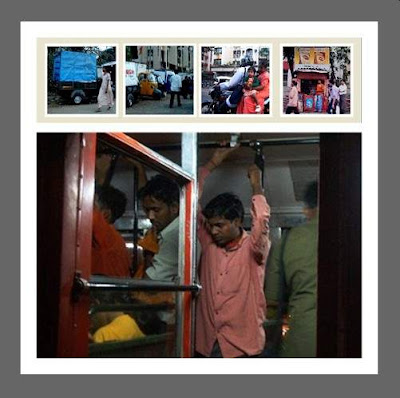 Located on the west coast of India, the group of islands which has grown into the city of Mumbai, was probably first recorded as the home of fisherfolk where a group of Buddhist monks established an outpost late during the Magadhan empire.
Located on the west coast of India, the group of islands which has grown into the city of Mumbai, was probably first recorded as the home of fisherfolk where a group of Buddhist monks established an outpost late during the Magadhan empire.The islands were tossed from one king to another emperor for two millenia, until the maritime trade empire of the British decided to develop the natural harbour into a city.
In the four hundred years since then, the city has grown by a series of land reclamations which now link the original islands into one mass.
The name Mumbai has been used in the main local languages for as long, and is ascribed to the local goddess Mumba (means mother in Marathi). The name of the city was changed to Mumbai by an act of the parliament in 1997.

Mumbai is called the financial capital of India: the stock exchange is the primary stock exchange of the country; most large business houses have their corporate offices in this city.
It also the primary center for the arts and the entertainment industry. In India it is the city of gold, of dreams. Everyone comes here to make money. However, Bombay does sleep at night although usually rather late and very briefly.

Mumbai boasts more cell phones per capita than any other city on the subcontinent. The city is responsible for generating one sixth of the gross domestic product of the entire country.
But Mumbai is bursting at the seams. The first glimpse of the city, as the airplane hits the runway, is Dharavi, Asia’s largest slum, home to 2.8 million people.
According to a 2004 estimate, the population of metropolitan Mumbai was approximately 17 million.
Every year, the city receives more than 250,000 rural-to-urban emigrants. Mumbai could be the world’s most populous city by 2020, with 28.5 million, says the Population Institute.
Bombay is energetic, exuberant, sparkling, and has building stones of many kinds and colours ...on your dyspeptic days you are apt to find Bombay's [architecture] bumptious, even riotous. In your more genial moments you might apply the adjective ... vital.
-John Begg
Consulting Architect to Bombay
“With this sizeable number of people, resources are getting increasingly scarce. Buildings are getting taller, with no care for where water and space, children’s playgrounds and parking areas will come from,” says Preeti Gopalkrishnan, Communications Executive of Population First, a sustainable human development program based in Mumbai.
Half of the metropolis’ population lacks running water or electricity, and the smoke from hundreds of thousands of open cooking fires joins with the sooty smoke from two-stroke auto rickshaws, belching taxis, diesel buses and coal-fired power plants in a symphony of air pollutants.
Breathing Mumbai’s inversion-trapped air, experts say, is the equivalent of smoking 20 cigarettes a day.
 The water supply situation in Mumbai is critical, reports the UN, with the level of supply so much below demand that water use is restricted and reaches emergency proportions when the monsoon fails.
The water supply situation in Mumbai is critical, reports the UN, with the level of supply so much below demand that water use is restricted and reaches emergency proportions when the monsoon fails.
More than two million Mumbai residents have no sanitary facilities, and much sewage is discharged untreated or partially treated into waterways.
Attempts have been made to relocate industries outside the island city, but industrial pollution remains a serious problem.

There are more than 500,000 private automobiles on Mumbai streets. Despite a substantial public transit system, congestion in the metropolitan area continues.
As Business Week reports, “After years of neglect, combined with helter-skelter growth, Bombay is falling apart. Its suburban train service carries six million passengers a day, which works out to 570 per train car, nearly three times their capacity.”
“Public transport in Mumbai has reached a point of almost complete gridlock,” says Gordon Feller of the Urban Age Institute. “The emission standards of vehicles in the city are very bad and the local government is shy about talking about alternatives because it doesn’t know when it will implement them.”

Despite the high level of poverty in the city, however, crime isn’t increasing as rapidly as one would imagine.
According to the State of the World Cities Report, 2004/05, of all the world regions, developed and developing, Asia ranks lowest in almost all types of crimes. “I wouldn’t say there is rampant lawlessness; most people are going about their day-to-day life trying to scratch together a living,” Feller says. Yet daily life in Mumbai is extremely difficult. This is especially true of the city’s slum dwellers.
As the BBC reports, Mumbai’s poor build unstable, flimsy huts on any available land. The city’s older slums—such as Dharavi, Byculla and Khar—have houses made of brick and mortar but lack drainage systems and toilets. Many people also live dangerously close to the railway tracks, which cut through the heart of Bombay.
 The Times of India regularly reports vehicles backing or barreling over children, or rows of sleeping citizens. “Bombay,” wrote V.S. Naipaul in the first sentence of his India: A Million Mutinies Now, “is a crowd.”
The Times of India regularly reports vehicles backing or barreling over children, or rows of sleeping citizens. “Bombay,” wrote V.S. Naipaul in the first sentence of his India: A Million Mutinies Now, “is a crowd.”

No comments:
Post a Comment